Lost Dunes Golf Club,
MI, USA
Green Keeper: Steve Jotzat

From behind the unique 2nd green complex.
Lost Dunes is a course that elicits strong feelings from people. It enjoys a dramatic location, being in a former sand quarry with 60 foot sand dunes surrounding it on three sides. Throw in three large pit lakes and abundant vegetation, and you have a visually striking environment in which to play golf.
So enamoured with the property, people fail to realize that it was far from ideal. The shape of the property is awkward and Interstate 94 separates the first seven holes from the clubhouse and the remaining holes. The sand quarry, though it sounds great, essentially had a flat bottom.
No doubt about it – the selected architect was going to have to work hard to get it right. Given the penal nature of the scrubby environs and the fact that water is on play on nine holes, this course could easily have become one of those hyper-difficult 150 slope courses that you play once or twice and never again. But this is where Tom Doak excelled. He routinely built wide fairways of 60 plus yards. In one round, one of the authors hit all thirteen without putting on a shotmaking clinic.
Of course, where there are wide fairways on a Doak course, there are Doak greens at the end to greet you. Unlike most courses built today (in fact the very ones that receive the ‘best of’ awards from a certain publication), the greens here really and truly dictate the strategy back on the tee. This course isn’t just some ruggedly handsome poster boy with no brains. Far from it. The course harkens back to the days of alternate paths toward greens that keep the game just that – a game.
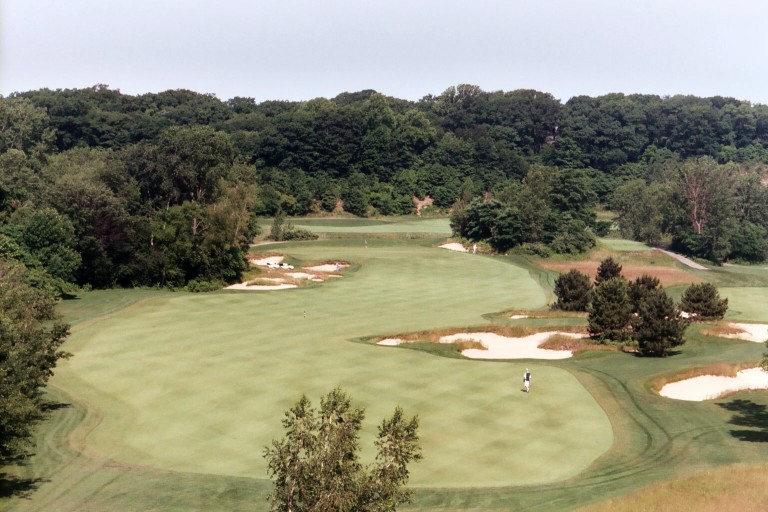
The character of Lost Dunes is revealed from the top tee at the 12th: the tee is on a sand dune that falls sixty feet to a relatively flat bottom, the fairy width and bunkering is on a large scale providing strategic options, and the green is full of interior contour.
The green complexes leave players shaking their heads – in admiration, confusion, dislike or a combination thereof. No one today makes wilder greens on a small scale than Doak, and these are his wildest. They take quite a bit of getting to know, but importantly, this is a private club and the members aregranted just such an opportunity.
As an example of the strategy on display, take the par five 10th. Reachable for some in two, the majority of us will lay up. A stream fronts the green some twenty yards short and wraps around its left side. The lay up appears straightforward on this straight hole: lay it up directly in line with the hole from the fairway. Wrong! The green’s several levels are angled well left to reward a lay-up down the far left side, a full thirty yards left of where the golfer would have originally thought. From over here, the golfer enjoys a simple pitch with the option of using one of the ridges as a backstop. Perhaps the 7th at Hollywood Golf Club served as the inspiration for this green.

Note how the angle of the ridges dictate where to lay up on the 10th hole. The strong two shot 11th hole is in the background.
Competing for the golfer’s attention with the greens and the surrounds is the extravagant bunkering. Doak and Tom Mead tied these ragged bunkers beautifully into their surrounds, and thus they complement and highlight the general natural beauty. The vegetation in and around the fairway bunker on the very first hole is a perfect example.
To find a course with such dramatic bunkering and greens that is not over-the-top and that is blessed with sound strategic requirements is very encouraging. Also, too, taking a page from many of the great architects from golf’s Golden Age,Doak providesgive and take during the round. The difficult stretch from holes 5 through 11 is followedby the downhill 12th, the little par three 13th hole, the medium length 14thand the reachable 15th where good scoring can be had if thegolfer finds the right portion of the greens. Too many modern courses mercilessly beat the player up with one result being little desire to ever return. The opposite is the case at Lost Dunes where the golfer continually learns something that he can apply to better his next round.

The stretch of holes from the 12th through the 15th provides hope for the thinking golfer. Pictured above is the one shot 13th.

Visually, Lost Dunes is a handsome course with great texture. Pictured is the view from the 14th tee.
Unlike most architects who seek a dramatic look, Doak moved little earth, especially on the course’sfinest sustained stretch of holes 1-7. In fact, Doak believes that the bunkering and greens may off-set each other – that many players will like the bunkering so much as not to become too concerned with the severe greens.
Holes to Note
1st hole, 385 yards: An ideal opening hole – short enough so as not to require driver from the tee but the fairway is wide enough to encourage its use. The green is an extension of the fairway and continues to slope away from the golfer. The approach reminds one of a typical St. Andrews shot, where just the top half of the flagstick is visible but the player knows that, because of the marvelous undulations in the green, a precise shot is required.
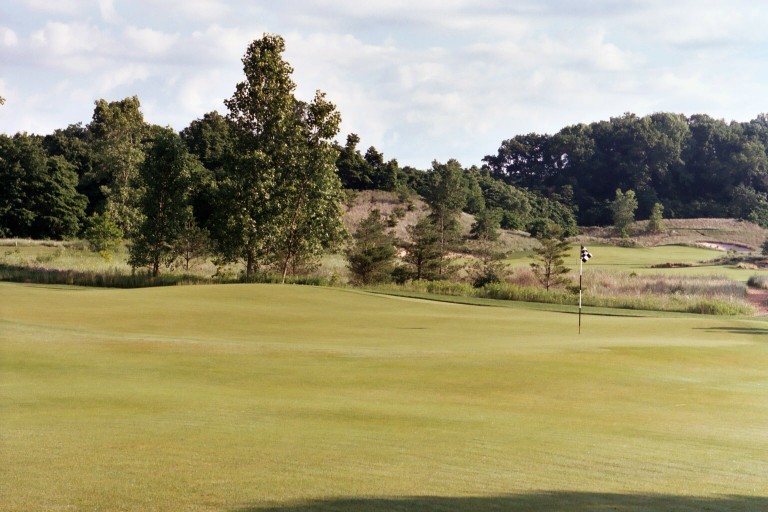
The stunning 1st green, glued to ground and falling from front to back away from the player. As with many classic links, where the fairway ends and the green begins can be hard to discern.
2nd hole, 440 yards: A slight dogleg to the right, the bunker to the left of the fairway (almost directly ahead) is deceiving in that it is not reachable from the tee but it steers players toward the real trouble, which is the bunkers jutting in from the right. A player with confidence in his swing will challenge those bunkers to leave him a better angle of approach. Off the tee, there is plenty of room to the left for a conservative play, but the approach shot is proportionately more difficult. The strategy and bunkering make this the most satisfying driving hole on the course. The wide green is protected by a natural mound that obscures the left hole locations from the fairway. This hole plays similar to the Road Hole in that the ridge in front of the green is death and yet there is plenty of room wide right from which a chip and a putt will do nicely.
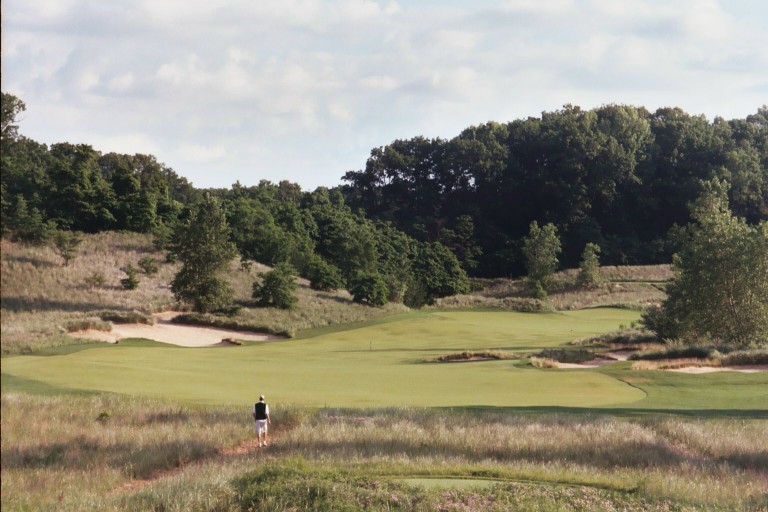
Width is a key element at Lost Dunes. Downwind, the golfer tries to carry the bunker complex on the right, thus given him the ideal angle into the (partially hidden) green. Into the wind, the golfer’s line off the tee is 30 yards left, toward the large bunker on the hillside.
4th hole, 510 yards: The hole plays shorter than its distance given the downhill tee shot and the amount of the dog-leg left that the player cuts off with his drive. As with most holes at Lost Dunes, the fairway is generous, important on this hole as it encourages the big play off the tee to enable the player to get home in two. If he can’t make it, he has countless lay up options. This mental dilemma for the second shot makes the hole. The green, with a nine-foot drop from back to front, cannot be described in words.
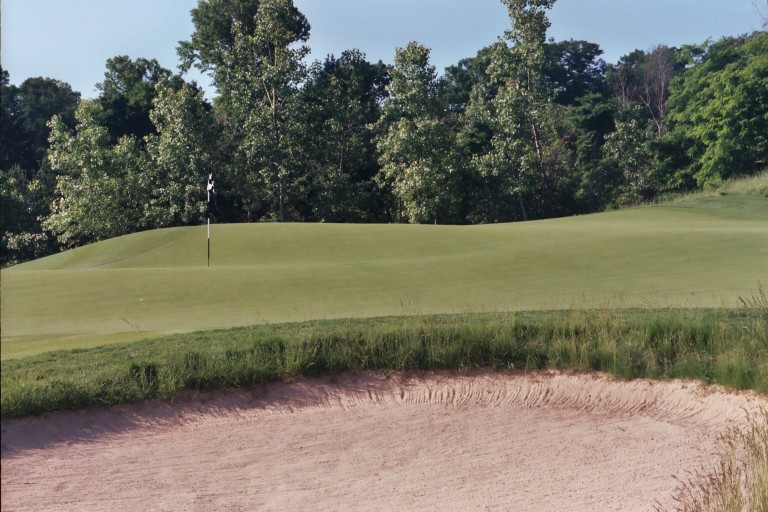
The wild 4th green more than defends par on this relatively short three shotter.
5th hole, 225 yards: Somewhat reminiscent of the 4th at Riviera and other George Thomas long one shotters, thismodified reverse Redan plays downhill to a large green with a deep front bunker. The slope short and left of the green can be used to propel the long-iron or fairway-wood shot onto the green, which slopes away from the tee. A low running bunker shot played from the front bunker with a nine iron is most enjoyable to watch as the ball rolls some thirt-five yards toward the back hole locations.
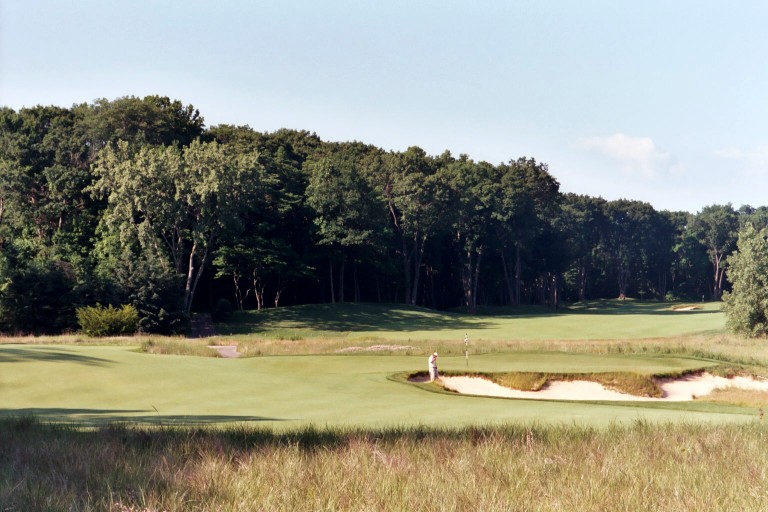
The mound highlighted by the second set of shadows on the left of the photograph can be used to kick the ball right and onto the large green.
7th hole, 445 yards: After driving over or left of the most intimidating bunker on the course, the player faces a lengthy shot into the slightly raised green with deep bunkers on both sides. The green is bisected by a ridge that dictates the proper play off the tee to this super wide fairway. If the hole is on the left (which one notes from the nearby first tee), the play is down the right side. The bold bunkering, alternate routes and rolling green conspire to remind the authors of golf architecture from days long gone by. Jeff Shearer, the owner of Lost Dunes, has learnedthrough trail and error that the course plays its best when the greens are held to under 10 on the stimpmeter. Anything higher and thegreens starts to lose some of theirmost interesting hole locations.
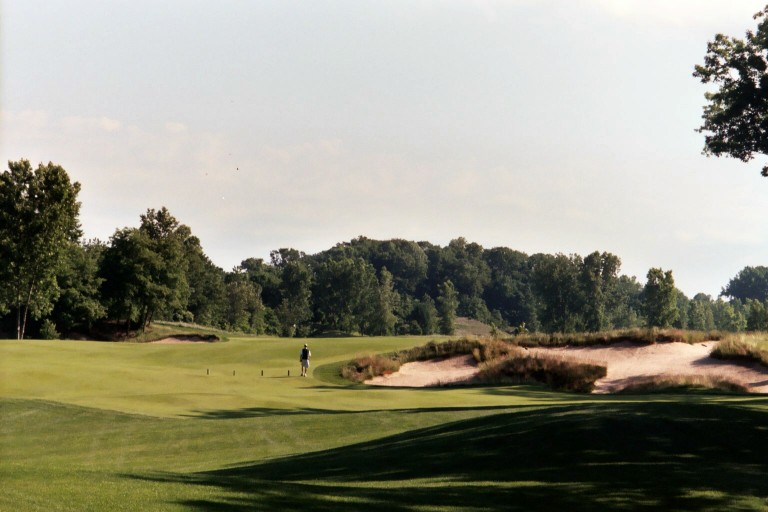
The magnificent bunker off the 7th tee.
11th hole, 425 yards:Perhaps the most appealing approach shot on the course,the two-level green is set in a saddle and is split left and right, with the higher side on the right, behind the fourteen foot (!) greenside bunker. The bank off the right side of the green is mowed tight and should be used to find the top right hole locations. A recovery shot from the bunker is high octane excitement as well.

The golfer sees all from the elevated 11th tee with the day’s hole location dictating the play – because of the saddle nature of the green, if the flag is right, the golfer is best served to go left off the tee and vice versa.
15th hole, 505 yards: The tee shot is of the Cape variety as the fairway swings right around the pit lake. The hole can be reached in two on some days, but typically, the lay-up second is to a wide fairway at the bottom of the slope. In fact the fairway is so wide, the player may be tricked into laying too much up the hill and leave himself with a dreaded part shot from an awkward stance. The smallish green isa marveland offers a difficult rear hole location where the target becomes increasingly tight.
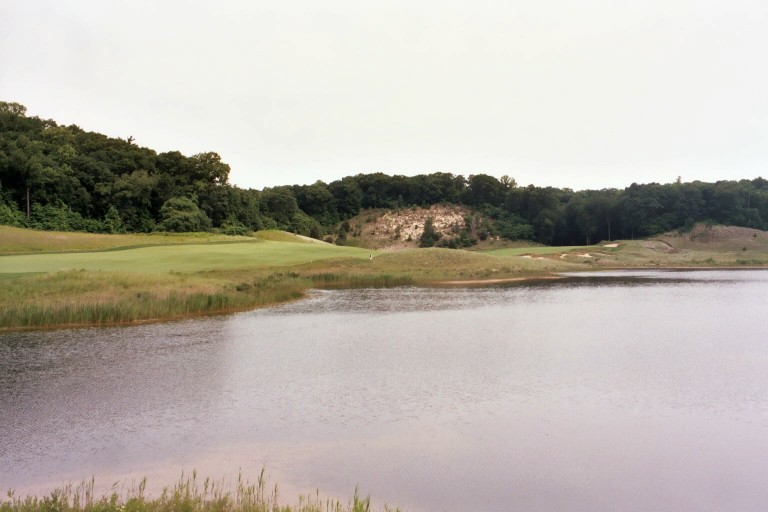
As seen from the tee, the 15th fairway sweeps along the western edge of the property along the base of sand dunes.
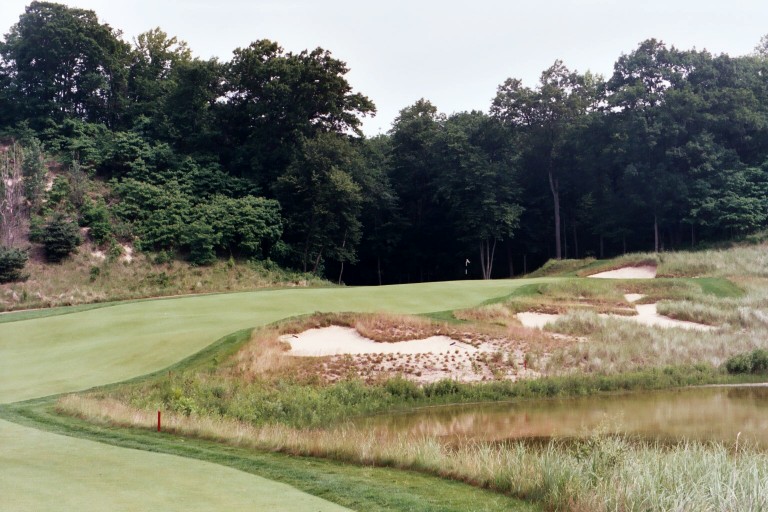
The knob that is the 15th green sheds balls left, right, over and short!
17th hole, 425 yards; Refreshing among modern courses,Lost Dunespossesses a large amount ofsubtlety. Take the 17th, which seemingly plays in a direct line off the tee. However, the best line is actually toward the left fairway bunker. In that manner,the approach shot is a) aimed away from the left hand bunker that eats into the green and b) can run directly up the length of the two tiered green. Green Keeper Steve Jotzat has done a wonderful job in 2003 and 2004 in making the course play as firm and fast as possible. Getting a running approach shot to stop on the top level of the 17th green is one of the most fun shots on the course.
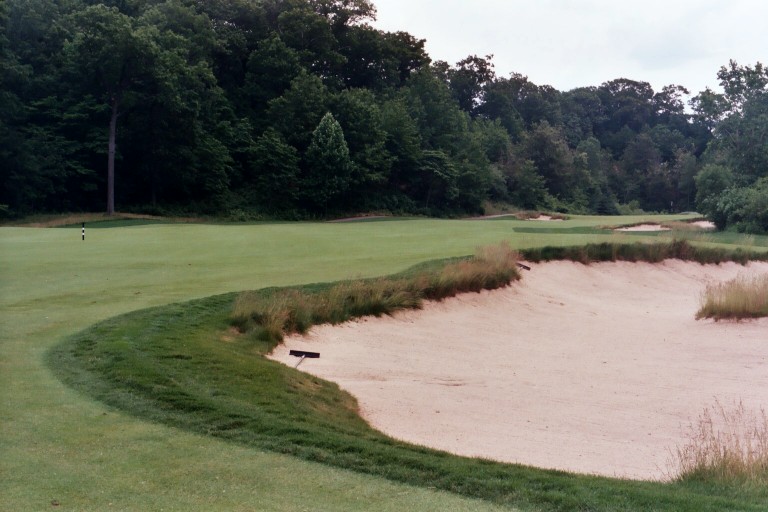
No reason to flirt with this right bunker off the 17th tee as the green opens up from the left of the fairway.
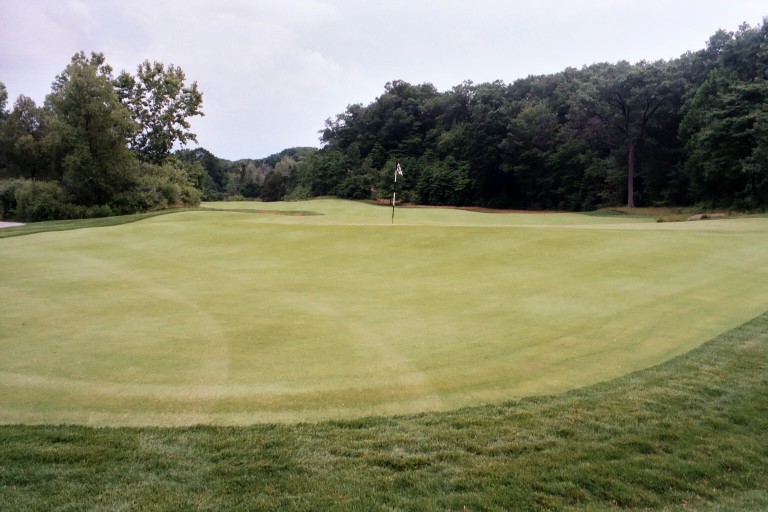
A view from behind the 17th shows the angle of the green pointing toward the left portion of the fairway. Also, an approach shot just a shade firm can run 8 to 10 paces beyond the pushed up 17th green, leaving a ticklish recovery shot that can be played one of several ways.
The only downside to Lost Dunes is the highway. However, its main impact is not unsightliness (which is minimal as it is well-hidden) but the fact that it makes for a difficult walk. From the clubhouse to the 1st tee and from the 7th green to 8th tee can be tough going. Despite these forced marches, Doak designed Lost Dunes with walking in mind and the author has always toured the course in under four hours.
In short, Lost Dunes incorporates great visual appeal with width off the tee to provide options that culminate in interesting putting greens of which one could never grow tired. The author played 36 holes here one October day and then … kept going until well past daylight. No greater compliment can be paid than having players squeeze every last shot out of a day.
The End





![The Park, West Palm (Lit 9) [2023]](https://golfclubatlas.com/wp-content/uploads/2024/12/IMG_7092-2-scaled-500x383.jpg)


